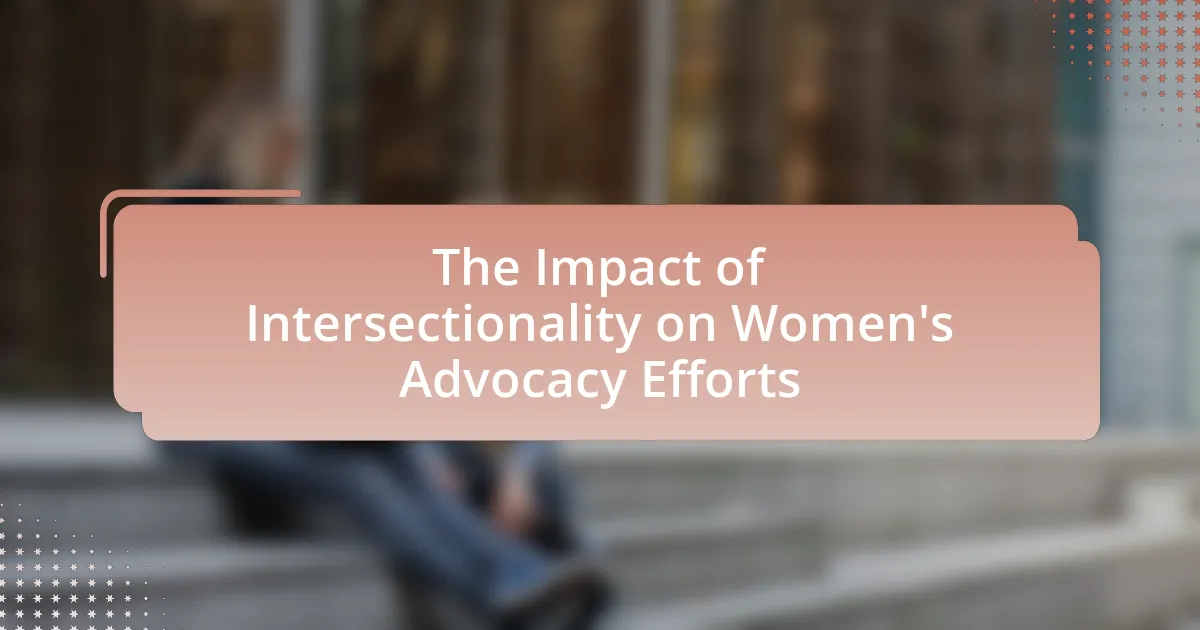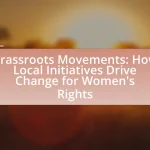The article examines the impact of intersectionality on women’s advocacy efforts, emphasizing how this framework enhances the understanding of diverse experiences faced by women due to overlapping identities such as race, class, sexuality, and ability. It discusses the influence of intersectionality on advocacy goals, highlighting the necessity for tailored strategies that address the unique challenges of marginalized groups, particularly women of color. Key components of intersectionality, historical contexts, and the evolution of the concept are explored, along with current challenges and opportunities in intersectional advocacy. The article also outlines best practices for advocates to incorporate intersectionality into their efforts, emphasizing the importance of collaboration and inclusive strategies for effective policy-making.
What is the Impact of Intersectionality on Women’s Advocacy Efforts?
Intersectionality significantly enhances women’s advocacy efforts by recognizing and addressing the diverse experiences and challenges faced by women based on overlapping identities such as race, class, sexuality, and ability. This framework allows advocates to create more inclusive policies and programs that reflect the realities of marginalized groups, leading to more effective and equitable outcomes. For instance, research by Crenshaw (1989) highlights how Black women experience discrimination differently than white women or Black men, underscoring the necessity of intersectional approaches in advocacy to address specific needs and barriers. By incorporating intersectionality, advocacy efforts can mobilize a broader coalition of support and foster solidarity among various groups, ultimately strengthening the movement for gender equality.
How does intersectionality influence the goals of women’s advocacy?
Intersectionality influences the goals of women’s advocacy by emphasizing the interconnected nature of social categorizations such as race, class, gender, and sexuality, which creates overlapping systems of discrimination or disadvantage. This framework allows advocates to address the unique challenges faced by women who belong to multiple marginalized groups, ensuring that advocacy efforts are inclusive and representative. For instance, studies show that Black women experience both racial and gender discrimination, which necessitates tailored advocacy strategies that address their specific needs, as highlighted in the research by Crenshaw (1989) in “Mapping the Margins.” By incorporating intersectionality, women’s advocacy can more effectively promote policies that consider the diverse experiences of all women, leading to more equitable outcomes.
What are the key components of intersectionality in the context of women’s advocacy?
The key components of intersectionality in the context of women’s advocacy include the recognition of multiple, overlapping social identities and the ways these identities intersect to create unique experiences of discrimination and privilege. Intersectionality emphasizes that factors such as race, class, sexuality, ability, and gender do not operate independently but interact to shape individual experiences and systemic inequalities. For instance, a study by Crenshaw (1989) highlighted how Black women face distinct challenges that are not fully addressed by feminist or anti-racist movements alone, illustrating the necessity of an intersectional approach in advocacy efforts. This framework allows advocates to develop more inclusive strategies that address the specific needs of diverse groups of women, ultimately leading to more effective and equitable outcomes in women’s rights initiatives.
How do different identities intersect to shape women’s experiences?
Different identities intersect to shape women’s experiences by creating unique social positions that influence their access to resources, opportunities, and treatment in society. For instance, a woman who identifies as both Black and LGBTQ+ may face compounded discrimination that differs from that experienced by a white heterosexual woman, affecting her economic stability, mental health, and social support networks. Research by Crenshaw (1989) highlights how intersectionality reveals the multifaceted nature of discrimination, demonstrating that women of color often encounter barriers that are not solely based on gender or race but rather on the interplay of multiple identities. This intersectional lens is crucial for understanding the diverse challenges women face and for developing effective advocacy strategies that address these complexities.
Why is understanding intersectionality crucial for effective advocacy?
Understanding intersectionality is crucial for effective advocacy because it recognizes that individuals experience overlapping social identities, which can lead to unique forms of discrimination and privilege. This framework allows advocates to address the specific needs and challenges faced by marginalized groups, ensuring that advocacy efforts are inclusive and comprehensive. For instance, research by Crenshaw (1989) highlights how Black women face discrimination that is not fully understood when considering race or gender in isolation. By incorporating intersectionality, advocates can develop targeted strategies that address the complexities of social justice issues, ultimately leading to more effective and equitable outcomes.
What challenges do advocates face when ignoring intersectionality?
Advocates face significant challenges when ignoring intersectionality, primarily the risk of oversimplifying complex social issues. This oversimplification can lead to ineffective advocacy strategies that fail to address the unique experiences of individuals at the intersections of multiple identities, such as race, gender, and socioeconomic status. For instance, research by Crenshaw (1989) highlights how Black women experience discrimination differently than white women or Black men, demonstrating that a one-size-fits-all approach can overlook critical nuances. Consequently, advocates may alienate marginalized groups, reduce the effectiveness of their campaigns, and perpetuate systemic inequalities by not recognizing the interconnected nature of social categorizations.
How can intersectionality enhance the inclusivity of advocacy efforts?
Intersectionality enhances the inclusivity of advocacy efforts by recognizing and addressing the multiple, overlapping identities and experiences individuals possess. This approach allows advocates to tailor their strategies to meet the diverse needs of marginalized groups, ensuring that no one is left behind. For example, research by Crenshaw (1989) highlights how Black women face unique challenges that are not addressed by feminist or anti-racist movements alone. By incorporating intersectionality, advocacy efforts can create more comprehensive policies that reflect the realities of those affected, leading to more effective and equitable outcomes.
What are the historical contexts of intersectionality in women’s advocacy?
Intersectionality in women’s advocacy emerged from the recognition that women’s experiences are shaped by multiple, intersecting identities, including race, class, sexuality, and ability. This concept was notably articulated by Kimberlé Crenshaw in the late 1980s, highlighting how traditional feminist movements often overlooked the unique challenges faced by women of color and other marginalized groups. Historical contexts include the suffrage movement, where white women sought voting rights while often excluding women of color, and the civil rights movement, which sometimes sidelined gender issues. These contexts illustrate the necessity of an intersectional approach to address the diverse realities of women’s lives, as evidenced by the formation of organizations like the Combahee River Collective in 1974, which explicitly addressed the intersections of race, gender, and sexuality in their advocacy.
How has the concept of intersectionality evolved over time?
The concept of intersectionality has evolved from its initial formulation by Kimberlé Crenshaw in 1989, which highlighted how overlapping social identities, particularly race and gender, create unique experiences of discrimination. Over time, intersectionality has expanded to encompass a broader range of identities, including class, sexuality, ability, and age, reflecting a more nuanced understanding of how systemic inequalities intersect. This evolution has been influenced by various social movements and academic discourse, leading to its integration into feminist theory, critical race theory, and social justice advocacy. The recognition of intersectionality’s complexity has prompted advocacy efforts to address the specific needs of marginalized groups, thereby enhancing the effectiveness of women’s advocacy initiatives by ensuring that diverse voices and experiences are included in the dialogue.
What key movements have contributed to the development of intersectionality?
Key movements that have contributed to the development of intersectionality include the civil rights movement, feminist movements, and LGBTQ+ rights movements. The civil rights movement, particularly in the 1960s, highlighted the interconnectedness of race and social justice, influencing scholars like Kimberlé Crenshaw to articulate how overlapping identities affect experiences of discrimination. Feminist movements, especially those advocating for women of color, emphasized that gender cannot be examined in isolation from race and class, leading to a broader understanding of women’s issues. Additionally, LGBTQ+ rights movements have underscored the importance of recognizing how sexual orientation and gender identity intersect with other social categories, further enriching the discourse on intersectionality. These movements collectively laid the groundwork for a more nuanced analysis of social inequalities, demonstrating that various forms of oppression are interconnected.
How have historical figures influenced intersectional advocacy?
Historical figures have significantly influenced intersectional advocacy by highlighting the interconnectedness of various social identities and injustices. For instance, figures like Kimberlé Crenshaw, who coined the term “intersectionality,” emphasized how race, gender, and class intersect to create unique experiences of oppression. Additionally, activists such as Audre Lorde and bell hooks have advocated for the inclusion of diverse voices within feminist movements, stressing that women’s experiences cannot be understood in isolation from other social categories. Their contributions have laid the groundwork for contemporary intersectional frameworks, which are now essential in addressing the complexities of social justice issues.
What role do intersectional identities play in shaping advocacy strategies?
Intersectional identities significantly influence advocacy strategies by ensuring that diverse experiences and needs are represented. Advocacy efforts that acknowledge intersectionality can address the unique challenges faced by individuals at the intersections of multiple identities, such as race, gender, sexuality, and socioeconomic status. For instance, research by Crenshaw (1989) highlights how Black women experience discrimination differently than either Black men or white women, necessitating tailored advocacy approaches that consider these overlapping identities. This nuanced understanding allows advocates to create more effective policies and campaigns that resonate with a broader audience, ultimately leading to more inclusive and impactful outcomes in women’s advocacy efforts.
How can advocates tailor their approaches to different intersectional identities?
Advocates can tailor their approaches to different intersectional identities by employing strategies that recognize and address the unique experiences and challenges faced by individuals at the intersections of various social categories, such as race, gender, sexuality, and socioeconomic status. For instance, research indicates that women of color often experience compounded discrimination that requires advocates to develop culturally relevant messaging and support systems that resonate with their specific lived experiences. By utilizing data from studies like the “Intersectionality and Women’s Advocacy” report by Crenshaw (2019), which highlights the necessity of intersectional frameworks in advocacy, advocates can create targeted programs that effectively address the multifaceted nature of oppression. This tailored approach not only enhances the relevance of advocacy efforts but also fosters inclusivity and empowerment among diverse groups.
What are the implications of intersectional strategies on policy-making?
Intersectional strategies significantly enhance policy-making by ensuring that diverse perspectives and experiences are considered, leading to more equitable outcomes. These strategies recognize that individuals face multiple, overlapping forms of discrimination, such as race, gender, and socioeconomic status, which can influence their access to resources and opportunities. For example, research by Crenshaw (1989) highlights how Black women experience discrimination differently than white women or Black men, underscoring the need for policies that address these unique challenges. By incorporating intersectionality into policy-making, governments can create more inclusive frameworks that better serve marginalized communities, ultimately resulting in policies that are more effective and just.
What are the current challenges and opportunities in intersectional women’s advocacy?
Current challenges in intersectional women’s advocacy include systemic discrimination, lack of representation, and insufficient funding for diverse initiatives. These barriers hinder the effectiveness of advocacy efforts aimed at addressing the unique needs of women from various backgrounds, such as race, class, and sexual orientation. For instance, a report by the National Women’s Law Center highlights that women of color face higher rates of poverty and violence, which are often overlooked in mainstream advocacy.
Conversely, opportunities in intersectional women’s advocacy arise from increased awareness and solidarity among diverse groups. The rise of social media has facilitated grassroots movements, allowing marginalized voices to be amplified and fostering collaboration across different sectors. Research from the Women’s March Foundation indicates that intersectional approaches can lead to more comprehensive policy changes, as they address the interconnectedness of various social issues.
What barriers do intersectional advocates face today?
Intersectional advocates face significant barriers today, including systemic discrimination, lack of funding, and limited representation in decision-making processes. Systemic discrimination manifests through overlapping social identities, which can lead to compounded marginalization, making it difficult for advocates to address the unique needs of diverse communities effectively. Additionally, funding for intersectional initiatives is often scarce, as many organizations prioritize single-issue campaigns over multifaceted approaches. This financial limitation restricts the capacity of intersectional advocates to implement comprehensive strategies. Furthermore, limited representation in leadership roles within advocacy organizations and policy-making bodies hinders the ability of intersectional advocates to influence change and ensure that diverse voices are heard in critical discussions.
How do systemic inequalities impact advocacy efforts?
Systemic inequalities significantly hinder advocacy efforts by creating barriers that limit access to resources, representation, and influence. These inequalities manifest in various forms, such as economic disparities, racial discrimination, and gender biases, which collectively undermine the effectiveness of advocacy initiatives. For instance, marginalized groups often lack the financial means to participate in advocacy activities, resulting in underrepresentation in decision-making processes. According to a report by the National Women’s Law Center, women of color face compounded challenges that restrict their ability to advocate for their rights, illustrating how systemic inequalities directly affect the capacity and reach of advocacy efforts.
What role does funding play in supporting intersectional advocacy?
Funding is crucial in supporting intersectional advocacy as it enables organizations to address the diverse and overlapping identities of marginalized groups effectively. Financial resources allow these organizations to conduct research, develop targeted programs, and mobilize communities, ensuring that advocacy efforts are inclusive and representative of various experiences. For instance, a study by the Women’s Funding Network highlights that targeted funding for intersectional initiatives leads to more comprehensive policy changes and community engagement, demonstrating the direct impact of financial support on advocacy outcomes.
How can advocates leverage intersectionality for greater impact?
Advocates can leverage intersectionality for greater impact by recognizing and addressing the interconnected nature of social categorizations such as race, gender, and class. This approach allows advocates to create more inclusive policies and programs that reflect the diverse experiences of marginalized groups. For instance, research by Crenshaw (1989) highlights how Black women face unique challenges that are not addressed by feminist or anti-racist movements alone. By incorporating intersectional analysis, advocates can develop targeted strategies that address specific needs, ultimately leading to more effective advocacy outcomes.
What best practices can be adopted for intersectional advocacy?
Best practices for intersectional advocacy include actively listening to diverse voices, collaborating with marginalized communities, and integrating an intersectional lens into all advocacy efforts. Actively listening ensures that the unique experiences and needs of various groups are acknowledged and addressed, fostering inclusivity. Collaboration with marginalized communities enhances the effectiveness of advocacy by leveraging local knowledge and building trust. Integrating an intersectional lens involves recognizing how overlapping identities—such as race, gender, sexuality, and socioeconomic status—impact individuals’ experiences and challenges, which is crucial for creating comprehensive and effective advocacy strategies. Research by Crenshaw (1989) highlights the importance of intersectionality in understanding systemic inequalities, reinforcing the need for these practices in advocacy efforts.
How can collaboration among diverse groups enhance advocacy outcomes?
Collaboration among diverse groups enhances advocacy outcomes by leveraging a wide range of perspectives, experiences, and resources, which leads to more comprehensive and effective strategies. When various groups unite, they can address complex issues from multiple angles, ensuring that advocacy efforts are inclusive and representative of different communities. For example, research by the Women’s Funding Network indicates that coalitions that include diverse voices are more successful in influencing policy changes, as they can mobilize broader support and create more compelling narratives that resonate with a wider audience. This collaborative approach not only strengthens the advocacy message but also fosters solidarity among different groups, ultimately leading to more impactful outcomes in women’s advocacy efforts.
What practical steps can advocates take to incorporate intersectionality into their efforts?
Advocates can incorporate intersectionality into their efforts by actively engaging with diverse communities to understand their unique challenges and experiences. This involves conducting inclusive research that highlights the specific needs of marginalized groups, such as women of color, LGBTQ+ individuals, and those with disabilities. For instance, the 2019 report by the National Women’s Law Center emphasizes the importance of intersectional data collection to inform policy decisions that address the multifaceted nature of discrimination. Additionally, advocates should collaborate with organizations that represent various identities to amplify their voices and ensure that advocacy strategies reflect a broad spectrum of experiences. By implementing these steps, advocates can create more effective and inclusive initiatives that address the complexities of social justice issues.
How can training and education improve understanding of intersectionality?
Training and education can significantly improve understanding of intersectionality by providing individuals with the knowledge and tools to recognize and analyze the interconnected nature of social identities and systems of oppression. Educational programs that focus on intersectionality teach participants about the complexities of race, gender, class, sexuality, and other identities, highlighting how these factors influence experiences of discrimination and privilege. Research by Crenshaw, who coined the term “intersectionality,” emphasizes that understanding these overlapping identities is crucial for effective advocacy and policy-making. Furthermore, studies show that training initiatives that incorporate diverse perspectives foster empathy and critical thinking, enabling advocates to address the unique challenges faced by marginalized groups more effectively.
What resources are available for advocates to learn about intersectionality?
Advocates can access various resources to learn about intersectionality, including academic literature, online courses, and community workshops. Notable academic texts such as “Intersectionality” by Kimberlé Crenshaw provide foundational knowledge, while platforms like Coursera and edX offer courses on social justice that include intersectionality as a key concept. Additionally, organizations such as the Women’s Foundation and the Center for Intersectionality and Social Policy Studies host workshops and webinars that focus on practical applications of intersectionality in advocacy work. These resources are validated by their widespread use in educational settings and advocacy training programs, ensuring that advocates are equipped with a comprehensive understanding of intersectionality’s impact on women’s advocacy efforts.


